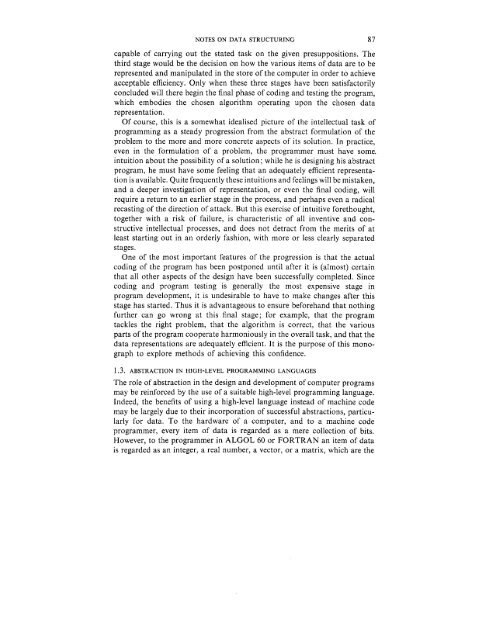II. Notes on Data Structuring * - Cornell University
II. Notes on Data Structuring * - Cornell University
II. Notes on Data Structuring * - Cornell University
Create successful ePaper yourself
Turn your PDF publications into a flip-book with our unique Google optimized e-Paper software.
NOTES ON DATA STRUCTURING 87<br />
capable of carrying out the stated task <strong>on</strong> the given presuppositi<strong>on</strong>s. The<br />
third stage would be the decisi<strong>on</strong> <strong>on</strong> how the various items of data are to be<br />
represented and manipulated in the store of the computer in order to achieve<br />
acceptable efficiency. Only when these three stages have been satisfactorily<br />
c<strong>on</strong>cluded will there begin the final phase of coding and testing the program,<br />
which embodies the chosen algorithm operating up<strong>on</strong> the chosen data<br />
representati<strong>on</strong>.<br />
Of course, this is a somewhat idealised picture of the intellectual task of<br />
programming as a steady progressi<strong>on</strong> from the abstract formulati<strong>on</strong> of the<br />
problem to the more and more c<strong>on</strong>crete aspects of its soluti<strong>on</strong>. In practice,<br />
even in the formulati<strong>on</strong> of a problem, the programmer must have some.<br />
intuiti<strong>on</strong> about the possibility of a soluti<strong>on</strong>; while he is designing his abstract<br />
program, he must have some feeling that an adequately efficient representa-<br />
ti<strong>on</strong> is available. Quite frequently these intuiti<strong>on</strong>s and feelings will be mistaken,<br />
and a deeper investigati<strong>on</strong> of representati<strong>on</strong>, or even the final coding, will<br />
require a return to an earlier stage in the process, and perhaps even a radical<br />
recasting of the directi<strong>on</strong> of attack. But this exercise of intuitive forethought,<br />
together with a risk of failure, is characteristic of all inventive and c<strong>on</strong>-<br />
structive intellectual processes, and does not detract from the merits of at<br />
least starting out in an orderly fashi<strong>on</strong>, with more or less clearly separated<br />
stages.<br />
One of the most important features of the progressi<strong>on</strong> is that the actual<br />
coding of the program has been postp<strong>on</strong>ed until after it is (almost) certain<br />
that all other aspects of the design have been successfully completed. Since<br />
coding and program testing is generally the most expensive stage in<br />
program development, it is undesirable to have to make changes after this<br />
stage has started. Thus it is advantageous to ensure beforehand that nothing<br />
further can go wr<strong>on</strong>g at this final stage; for example, that the program<br />
tackles the right problem, that the algorithm is correct, that the various<br />
parts of the program cooperate harm<strong>on</strong>iously in the overall task, and that the<br />
data representati<strong>on</strong>s are adequately efficient. It is the purpose of this m<strong>on</strong>o-<br />
graph to explore methods of achieving this c<strong>on</strong>fidence.<br />
1.3. ABSTRACTION IN HIGH-LEVEL PROGRAMMING LANGUAGES<br />
The role of abstracti<strong>on</strong> in the design and development of computer programs<br />
may be reinforced by the use of a suitable high-level programming language.<br />
Indeed, the benefits of using a high-level language instead of machine code<br />
may be largely due to their incorporati<strong>on</strong> of successful abstracti<strong>on</strong>s, particu-<br />
larly for data. To the hardware of a computer, and to a machine code<br />
programmer, every item of data is regarded as a mere collecti<strong>on</strong> of bits.<br />
However, to the programmer in ALGOL 60 or FORTRAN an item of data<br />
is regarded as an integer, a real number, a vector, or a matrix, which are the

















